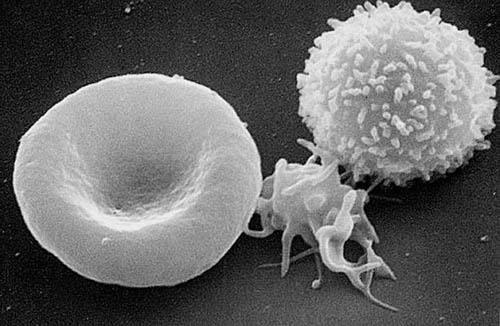USC Stem Cell researchers poke around for blood genes

From left to right, a red blood cell, a platelet and a white blood cell are shown. Credit: Public domain image courtesy of the Electron Microscopy Facility at The National Cancer Institute at Frederick
The Allayee and Adams labs performed a genetic screen of a collection of more than 100 mouse strains that are commonly used in laboratories, called the hybrid mouse diversity panel.
The researchers found that different strains have different numbers of several important sub-populations of blood stem cells, including those called “short-term HSCs,” which are responsible for the formation of red and white blood cells in adults. The activation of a gene called Hopx is associated with an increased number of short-term HSCs. The researchers further proved this finding by showing that mice lacking the Hopx gene form fewer short-term HSCs and are ineffective bone marrow donors.
“Short-term HSCs are the major stem cells in the adult bone marrow, so finding new genetic regulators of this subpopulation may have clinical benefits,” said Adams.
More broadly, the researchers have shown that the hybrid mouse diversity panel can be used to find genes that would otherwise go unnoticed.
“This powerful genetics platform has the potential to reveal the genes underlying other stem cell populations or a wide range of diseases that would be difficult to study in humans,” said Allayee.
###
The paper's lead authors are Xiaoying Zhou and Amanda L. Crow from USC, and additional contributors include: Jaana Hartiala, Tassja J. Spindler and Lora W. Barksy from USC; Anatole Ghazalpour, Brian W. Parks, Eleazar Eskin and Aldons J. Lusis from UCLA; Brian B. Bennett from the University of North Carolina, Chapel Hill; and Rajan Jain and Jonathan A. Epstein from the University of Pennsylvania.
This work was supported by the California Institute for Regenerative Medicine (grant TG2-01161), the National Institutes for Health (grants T32ES013678, K99HL102223, K99HL123021, R01ES022282, R01HL071546, P01HL30568, P01HL28481, R01ES021801, 3R01ES021801-03S1, UL1TR000130 and P3ES007048) and the Margaret E. Early Medical Research Trust.
Media Contact
All latest news from the category: Life Sciences and Chemistry
Articles and reports from the Life Sciences and chemistry area deal with applied and basic research into modern biology, chemistry and human medicine.
Valuable information can be found on a range of life sciences fields including bacteriology, biochemistry, bionics, bioinformatics, biophysics, biotechnology, genetics, geobotany, human biology, marine biology, microbiology, molecular biology, cellular biology, zoology, bioinorganic chemistry, microchemistry and environmental chemistry.
Newest articles

Recovering phosphorus from sewage sludge ash
Chemical and heat treatment of sewage sludge can recover phosphorus in a process that could help address the problem of diminishing supplies of phosphorus ores. Valuable supplies of phosphorus could…

Efficient, sustainable and cost-effective hybrid energy storage system for modern power grids
EU project HyFlow: Over three years of research, the consortium of the EU project HyFlow has successfully developed a highly efficient, sustainable, and cost-effective hybrid energy storage system (HESS) that…

After 25 years, researchers uncover genetic cause of rare neurological disease
Some families call it a trial of faith. Others just call it a curse. The progressive neurological disease known as spinocerebellar ataxia 4 (SCA4) is a rare condition, but its…





















